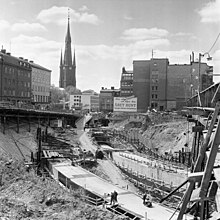Record years


The record years (Swedish: rekordåren) is a period in the economy of Sweden, dating from the international post–World War II economic expansion to the 1973 oil crisis,[1] and largely coinciding with the mandates of prime ministers Tage Erlander and earliest years of Olof Palme. The concept was originally a satirical left-wing description of the years 1968–70.
Sweden had maintained neutrality during both world wars, and entered the post-war boom with industrial and demographic advantages. Sweden also received aid from the Marshall Plan. Between 1947 and 1974, the Swedish economy grew at an average rate of 12.5% annually[citation needed]. The urban population, living in towns of over 15,000 people, grew from 38% of the total population in 1931 to 74% by 1973. Sustained by an export boom of automobiles, heavy machinery, electronics, shipbuilding, and heavy weapons, the per capita income increased by as much as 2,000%. Sweden had successfully moved into the high-income group of countries by 1955–56.
See also[edit]
- History of Sweden (1945–67)
- Folkhemmet
- Million Programme
- Trente Glorieuses
- Japanese post-war economic miracle
- Italian economic miracle
- Wirtschaftswunder
References[edit]
- ^ Rydén, Daniel (8 September 2013). "Krisen som skakade världens bästa land". Sydsvenskan (in Swedish). Retrieved 5 May 2016.


 French
French Deutsch
Deutsch